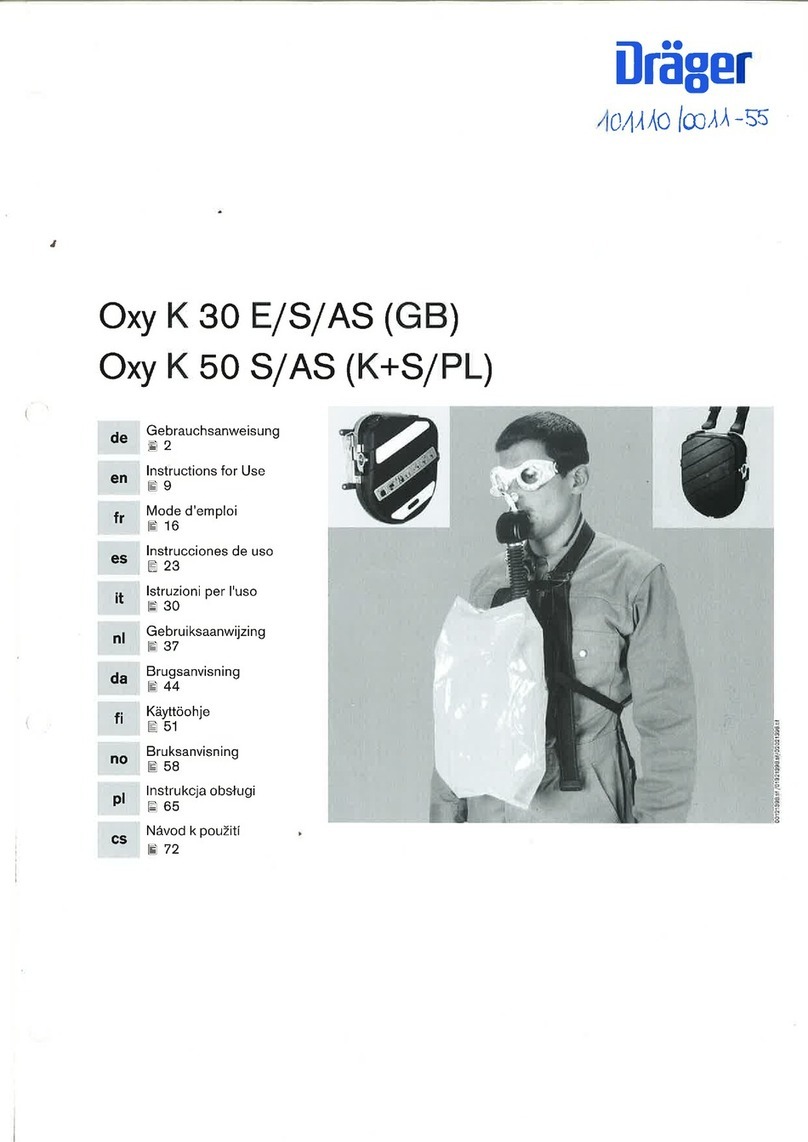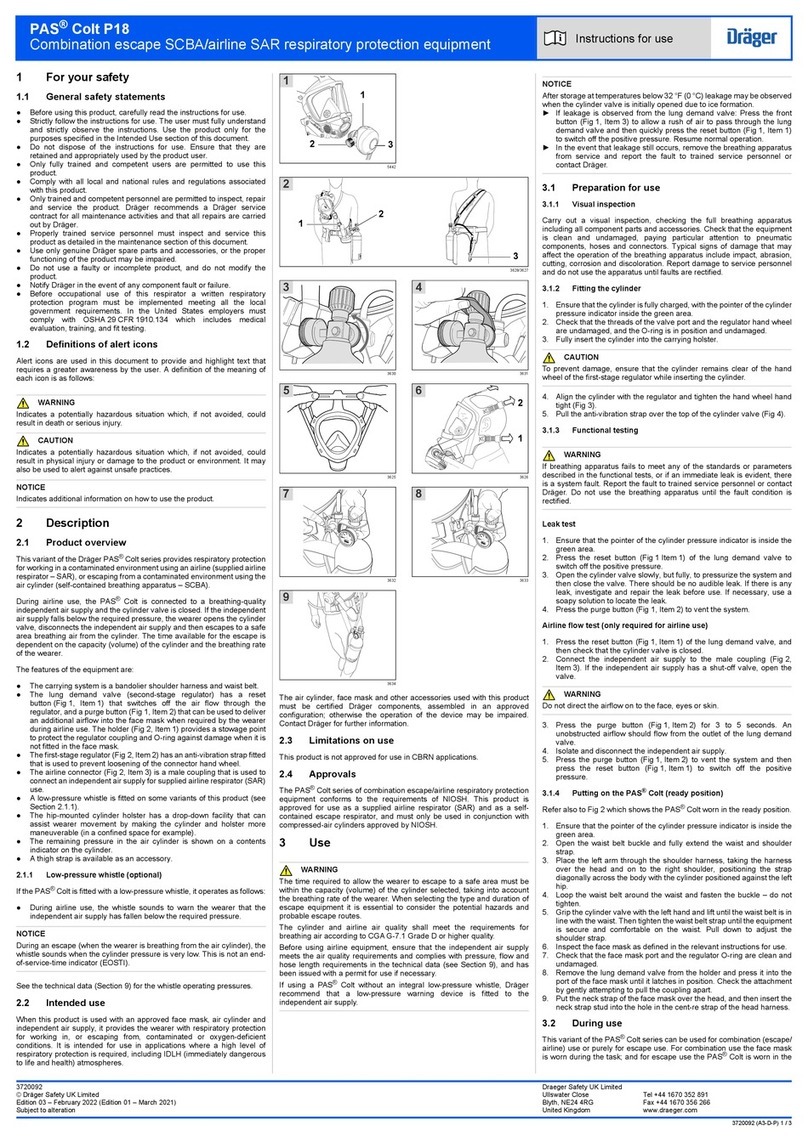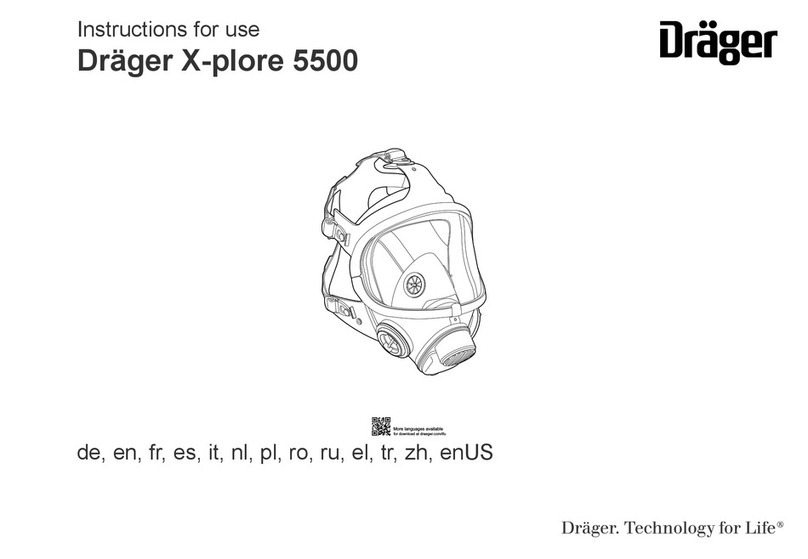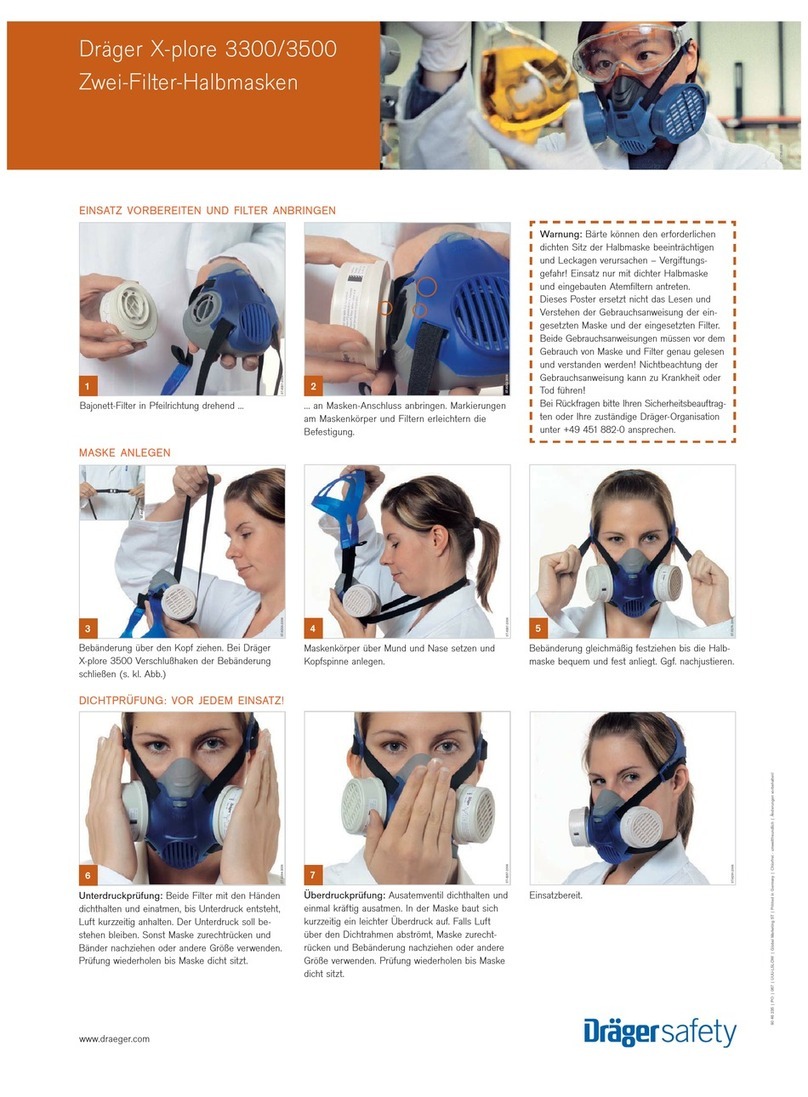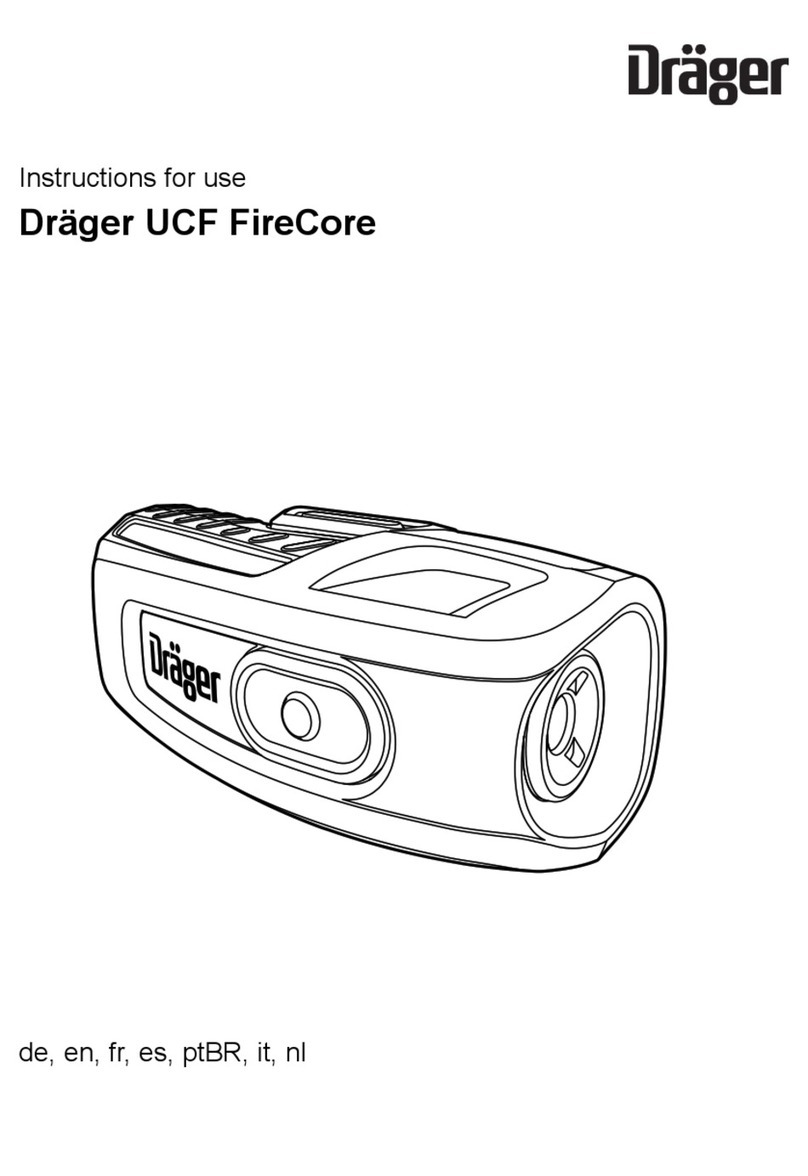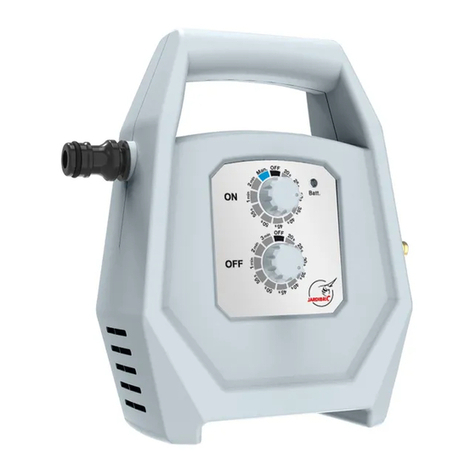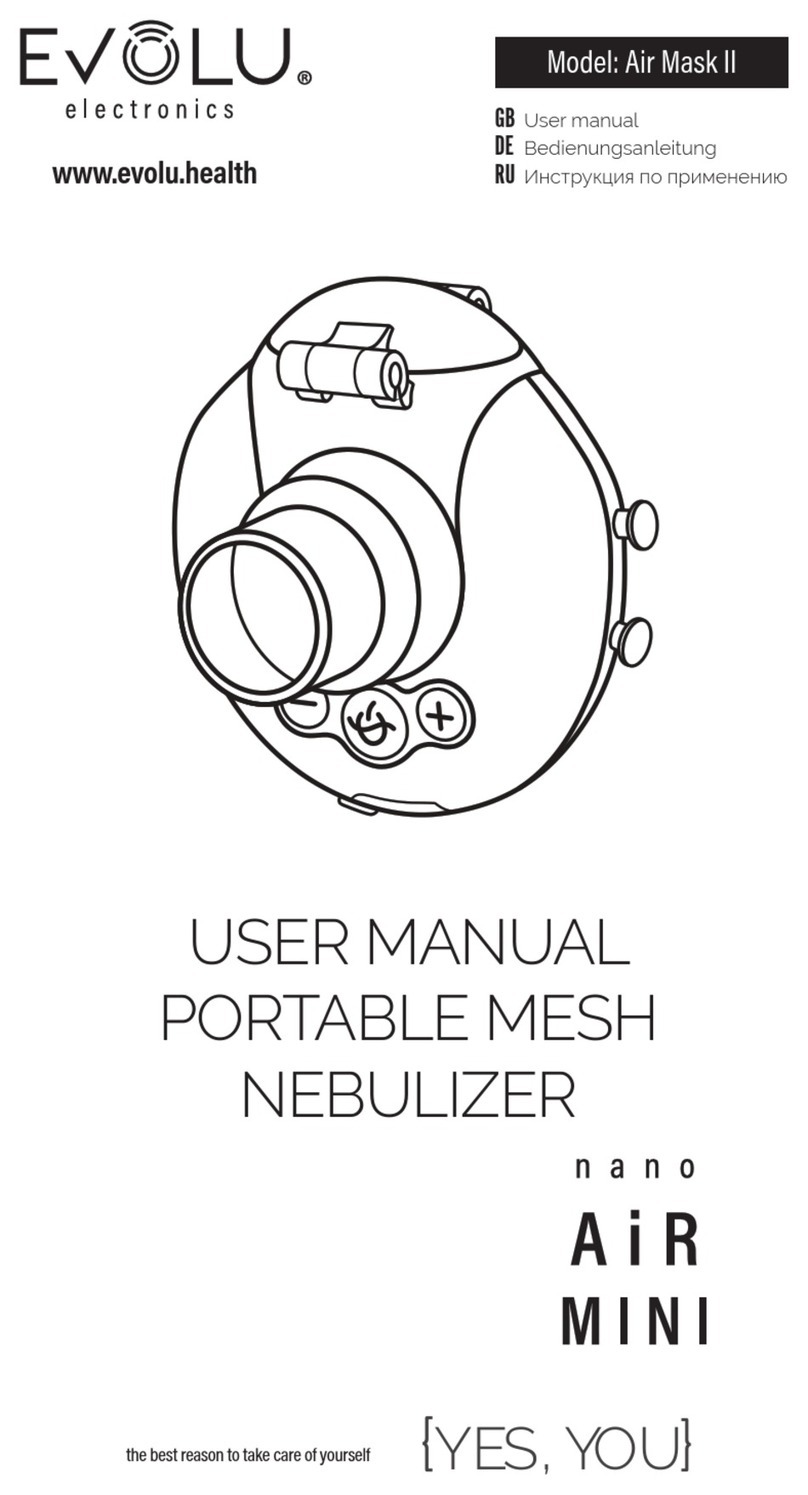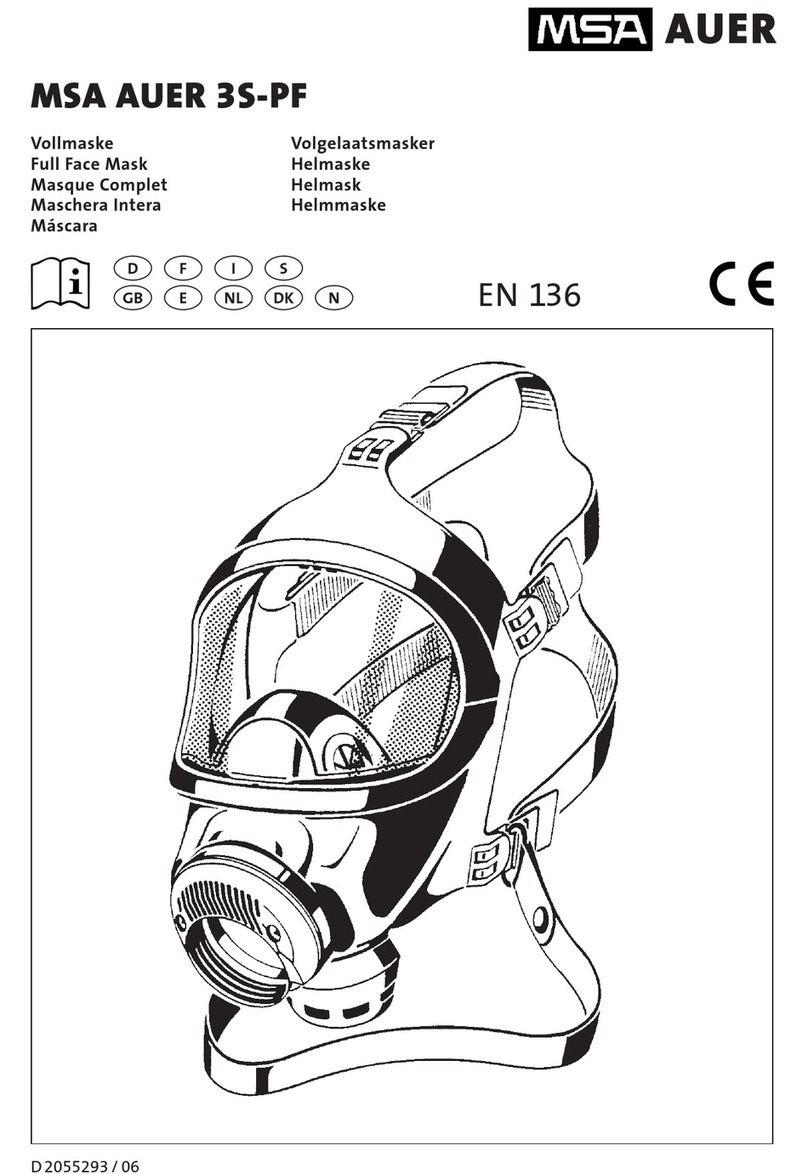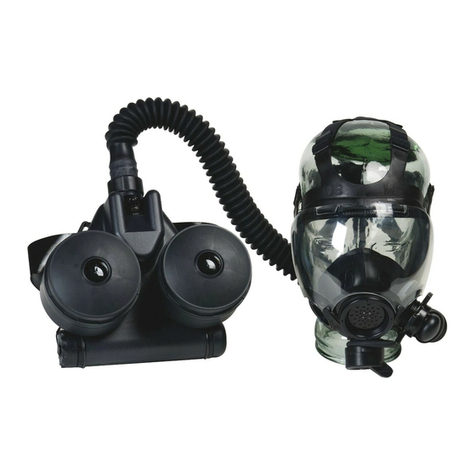
3359634 (A3-D-P)
PAS Colt Series with PAS ASV (Automatic Switch-over Valve)
Combination escape SCBA/airline SAR respiratory protection equipment Instructions for Use
1
21
3629
2
3690/3691
6
3625
8
3632
D
3000 PSI
EMPTY FUL
14
1234
USE
NO
OIL
4
5
3631
i
i
NOTICE
After storage at temperatures below 32 °F (0 °C) leakage may be observed when
the cylinder valve is initially opened due to ice formation.
● Ifleakageisobservedfromthelung demand regulator: Press the purge
button(Fig1,Item2)toallowarushofairtopassthroughthelungdemand
regulatorandthenquicklypresstheresetbutton(Fig1,Item1)toswitchoff
the positive pressure. Resume normal operation.
● Intheeventthatleakagestilloccurs,removethebreathingapparatusfrom
service and report the fault to trained service personnel or contact Dräger.
3.1 Preparation for use
3.1.1 Visual inspection
Carry out a visual inspection, checking the full breathing apparatus including all component
parts and accessories. Check that the equipment is clean and undamaged, paying
particular attention to pneumatic components, hoses and connectors. Typical signs of
damage that may affect the operation of the breathing apparatus include impact, abrasion,
cutting, corrosion and discoloration. Report damage to service personnel and do not use
theapparatusuntilfaultsarerectied.
3.1.2 Fitting the cylinder
1. Ensure that the cylinder is fully charged, with the pointer of the cylinder pressure
indicator inside the green area.
2. Check that the threads of the valve port and the regulator handwheel are undamaged,
and the O-ring is in position and undamaged.
3. Fully insert the cylinder into the carrying holster.
CAUTION
To prevent damage, ensure that the cylinder remains clear of the handwheel of
therst-stageregulatorwhileinsertingthecylinder.
1. Align the cylinder with the regulator and tighten the handwheel hand tight (Fig 4).
2. Pull the anti-vibration strap over the top of the cylinder valve (Fig 5).
3.1.3 Functional testing
!
WARNING
If the breathing apparatus fails to meet any of the standards or parameters
described in the functional tests, or if an immediate leak is evident, there is a
system fault. Report the fault to trained service personnel or contact Dräger. Do
notusethebreathingapparatusuntilthefaultconditionisrectied.
Leak test
1. Ensure that the pointer of the cylinder pressure indicator is inside the green area.
2. Presstheresetbutton(Fig1,Item1)ofthelungdemandregulatortoswitchoffthe
positive pressure.
3. Open the cylinder valve slowly, but fully, to pressurize the system and then close the
valve.Thereshouldbenoaudibleleak.Ifthereisanyleak,investigateandrepairthe
leakbeforeuse.Ifnecessary,useasoapysolutiontolocatetheleak.
4. Pressthepurgebutton(Fig1,Item2)toventthesystem.
Airline ow test (only required for airline use)
1. Presstheresetbutton(Fig1,Item1)ofthelungdemandregulator,andthencheck
that the cylinder valve is closed.
2. Connect the independent air supply to the male coupling (Fig 2, Item 3). If the
independent air supply has a shut-off valve, open the valve.
!
WARNING
Donotdirecttheairowontotheface,eyesorskin.
3. Pressthepurgebutton(Fig1,Item2)for3to5seconds.Anunobstructedairow
shouldowfromtheoutletofthelungdemandregulator.
4. Isolateanddisconnecttheindependentairsupply.
5. Pressthepurgebutton (Fig1, Item2)toventthesystemandthenpressthereset
button(Fig1,Item1)toswitchoffthepositivepressure.(ThePASASVwhistlewill
momentarily sound at the switch-over pressure of the automatic switch-over valve.)
3.1.4 Putting on the PAS Colt (ready position)
Refer also to Fig 2 which shows the PAS Colt worn in the ready position.
1. Ensure that the pointer of the cylinder pressure indicator is inside the green area.
2. Open the waist belt buckle and fully extend the waist and shoulder strap.
3. Place the left arm through the shoulder harness, taking the harness over the head
and on to the right shoulder, positioning the strap diagonally across the body with the
cylinder positioned against the left hip.
4. Loop the waist belt around the waist and fasten the buckle – do not tighten.
5. Grip the cylinder valve with the left hand and lift until the waist belt is in line with the
waist. Then tighten the waist belt strap until the equipment is secure and comfortable
on the waist. Pull down to adjust the shoulder strap.
6. InspectthefacemaskasdenedintherelevantInstructionsforUse.
7. Check that the face mask port and the regulator O-ring are clean and undamaged.
8. Remove the lung demand regulator from the holder and press it into the port of the
face mask until it latches in position. Check the attachment by gently attempting to pull
the coupling apart.
9. Put the neck strap of the face mask over the head, and then insert the neck strap stud
into the hole in the centre strap of the head harness.
3.2 During use
This variant of the PAS Colt Series can be used for combination (escape/airline) use or
purely for escape use. For combination use the face mask is worn during the task; and
for escape use the PAS Colt is worn in the ready position until an escape is necessary.
Depending on the intended use, refer to the relevant procedures from the following:
● Forcombination(escape/airline)use,seeSection3.2.1
● Forescapeuseonly,seeSection3.2.2
3.2.1 Combination (escape/airline) use
Putting on the face mask
1. Presstheresetbutton(Fig1,Item1)ofthelungdemandregulatortoswitchoffthe
positive pressure.
2. Connect the independent air supply to the male coupling (Fig 2, Item 3). If the
independent air supply has a shut-off valve, open the valve.
!
WARNING
Correct t of the face mask can only be achieved if the complete face mask
seal makes contact with skin. Head hair, facial hair (including beard stubble and
sideburns), earrings, other facial piercings and normal spectacles will interfere
with the face mask seal and are not permitted in the sealing area. Additionally,
headhairthatcouldaffectthefacemaskt(buns,pony-tails,hairpieces,etc.)is
not permitted.
i
i
NOTICE
ReferalsotothefacemaskInstructionsforUse.
3. Detach the neck strap stud from the center strap of the head harness.
4. Spread the head harness (Fig 6). Place the chin into the chin cup of the face mask and
pull the harness over the head locating the harness center plate on back of the head.
5. Referring to Fig 7, tighten both lower (1) and then upper straps (2) evenly towards
backofthehead.Ifnecessary,tightenthecenterstrap(3).Thewearer’srstinhalation
after achieving a face seal will automatically switch on the air supply into the face
mask.
6. Check that the head has a full range of movement without pulling against the regulator
hose.Ifanyresistancetomovementisfelt,readjustthehoseroutingandthenrecheck.
Ifresistanceisstillfelt,donotusethebreathingapparatusandcontactDräger.
Function check
1. Isolate the independent air supply (close the valve or disconnect) and breathe
normally to empty the system of air. When empty, the face mask should hold on to the
facetoindicateapositiveseal.(ThePASASVwhistlewillmomentarilysoundatthe
switch-over pressure of the automatic switch-over valve.)
2. Immediatelyreapplytheindependentairsupplyandbreathenormally.
3. Inhaleandholdyourbreath–thereshouldbenoaudibleleak.Ifaleakisdetected,
readjust the head harness and retest.
4. Recommencebreathing–exhaledairshouldoweasilyoutoftheexhalationvalve.
5. Momentarilypressthepurgebutton(Fig1,Item2)tocheckforadditionalairow.
When the function check has been satisfactorily completed, open the PAS Colt cylinder
valve, breathe normally and proceed to the working area.
Escape procedure (independent air supply failure)
!
WARNING
During supplied airline respirator (SAR) use, the PAS Colt cylinder valve remains
open.TheescapedurationstartsfromthetimethatthePASASVwhistlesounds.
Drägerstronglyadvisethatthepurgebutton(Fig1,Item2)isnotusedduringan
escape.Usingthepurgebuttonwoulduseairfromthecylinderandreducethe
time available for escape.
i
i
NOTICE
Duringairlineuse,thePASASVwhistlesoundstoindicatethattheindependent
airsupplyhasfallenbelowtherequiredpressure.Ifthewhistlesoundsandthen
stops before the escape procedure is started, the air supply pressure could have
beenrestored.Thewearermustconrmthatthecorrectpressure(87to125psi)
is available, or escape as described below.
Iftheindependentairsupplyfails,breathenormallyandimmediatelyproceedasfollows:
1. Disconnect the independent air supply from the PAS Colt.
2. Immediatelyleavethehazardousareabytheshortestandsafestescaperoute.
The wearer must be in a safe area before the air cylinder is empty. When in a safe area,
remove the lung demand regulator from the face mask if necessary and continue to
breathe normally.
3.2.2 Escape use only (putting on the face mask and escaping)
!
WARNING
Correct t of the face mask can only be achieved if the complete face mask
seal makes contact with skin. Head hair, facial hair (including beard stubble and
sideburns), earrings, other facial piercings and normal spectacles will interfere
with the face mask seal and are not permitted in the sealing area. Additionally,
headhairthatcouldaffectthefacemaskt(buns,pony-tails,hairpieces,etc.)is
not permitted.
i
i
NOTICE
ReferalsotothefacemaskInstructionsforUse.
1. Presstheresetbutton(Fig1,Item1)ofthelungdemandregulatortoswitchoffthe
positive pressure.
2. Open the cylinder valve (counterclockwise) slowly, but fully, to pressurize the system.
3. Detach the neck strap stud from the center strap of the head harness.
4. Spread the head harness (Fig 6). Place the chin into the chin cup of the face mask and
pull the harness over the head locating the harness center plate on back of the head.
5. Referring to Fig 7, tighten both lower (1) and then upper straps (2) evenly towards back
ofthehead.Ifnecessary,tightenthecenterstrap(3).Thewearer’srstinhalationafter
achieving a face seal will automatically switch on the air supply into the face mask.
!
WARNING
Thedurationofthecylinderairbeginsfromthetimeoftherst-breathactivation
of the lung demand regulator.
Drägerstronglyadviseagainstusingthepurgebutton(Fig1,Item2)duringan
escape.Usingthepurgebuttonwoulduseairfromthecylinderandreducethe
time available for escape.
6. Immediatelyleavethehazardousareabytheshortestandsafestescaperoute.
The wearer must be in a safe area before the air cylinder is empty. When in a safe area,
remove the lung demand regulator from the face mask if necessary and continue to breathe
normally.
7
3626
1
2
3
2
1
3
4
3630
10
3688
D
3000PSI
EMPTY FUL
14
1234
USE
NO
OIL
9
3633
D
3000 PSI
EMPTY FUL
14
1234
USE
NO
OIL
3
3687
1
1 For your safety
1.1 General safety statements
● Beforeusingthisproduct,carefullyreadtheInstructionsforUse.
● Strictly follow the Instructions for Use. The user must fully understand and strictly
observe the instructions. Use the product only for the purposes specied in the
IntendedUsesectionofthisdocument.
● Do not dispose of the Instructions for Use. Ensure that they are retained and
appropriately used by the product user.
● Onlyfullytrainedandcompetentusersarepermittedtousethisproduct.
● Complywithalllocalandnationalrulesandregulationsassociatedwiththisproduct.
● Onlytrainedandcompetentpersonnelarepermittedtoinspect,repairandservicethe
product. Dräger recommends a Dräger service contract for all maintenance activities
and that all repairs are carried out by Dräger.
● Properlytrainedservicepersonnelmustinspectandservicethisproductasdetailedin
the maintenance section of this document.
● UseonlygenuineDrägersparepartsandaccessories,ortheproperfunctioningofthe
product may be impaired.
● Donotuseafaultyorincompleteproduct,anddonotmodifytheproduct.
● NotifyDrägerintheeventofanycomponentfaultorfailure.
● Before occupational use of this respirator a written respiratory protection
program must be implemented meeting all the local government requirements.
IntheUnitedStatesemployersmustcomplywithOSHA29CFR1910.134which
includesmedicalevaluation,training,andttesting.
1.2 Denitions of alert icons
Alert icons are used in this document to provide and highlight text that requires a greater
awarenessbytheuser.Adenitionofthemeaningofeachiconisasfollows:
!
WARNING
Indicatesapotentiallyhazardoussituationwhich,ifnotavoided,couldresultin
death or serious injury.
CAUTION
Indicatesapotentiallyhazardoussituationwhich,ifnotavoided,couldresultin
physicalinjuryordamagetotheproductorenvironment.Itmayalsobeusedto
alert against unsafe practices.
i
i
NOTICE
Indicatesadditionalinformationonhowtousetheproduct.
2 Description
2.1 Product overview
This variant of the Dräger PAS Colt Series provides respiratory protection for working
in a contaminated environment using an airline (supplied airline respirator – SAR), or
escaping from a contaminated environment using the air cylinder (self-contained breathing
apparatus – SCBA).
The features of the equipment are:
● Thecarryingsystemisabandoliershoulderharnessandwaistbelt.
● Thelungdemandregulator(LDR)hasaresetbutton(Fig1,Item1)thatswitchesoff
theairowthroughtheregulator,andapurgebutton(Fig1,Item2)thatcanbeused
todeliveranadditionalairowintothefacemaskwhenrequiredbythewearerduring
airlineuse.Theholder(Fig2,Item1)providesastowagepointtoprotecttheregulator
couplingandO-ringagainstdamagewhenitisnotttedinthefacemask.
● Therst-stageregulator(Fig2,Item2)hasananti-vibrationstrapttedthatisuseto
prevent loosening of the connector handwheel.
● The Dräger PAS ASV (Fig 2, Item 4) allows the PAS Colt to be used with an
independent air supply such as a factory airline or other breathing air supply (e.g.
Dräger PAS AirPack). See Section 2.1.1 for a detailed description.
● Theairlineconnector(Fig2,Item 3) is a male coupling that is used to connectan
independent air supply for supplied airline respirator (SAR) use.
● The hip-mounted cylinder holster has a dropdown facility that can assist wearer
movement by making the cylinder and holster more manoeuvrable (in a conned
space for example).
● Theremainingpressureintheaircylinderisshownonacontentsindicator on the
cylinder.
● Athighstrapisavailableasanaccessory.
2.1.1 PAS ASV
ThePASASV(Fig2,Item4)isaswitch-overvalvethatautomaticallyswitchesbetweenan
airline supply and the PAS Colt air cylinder, maintaining an uninterrupted air supply to the
wearerduringswitching.Thereisawhistle(Fig3,Item1)ontheASVthatsoundstowarn
the wearer that the independent air supply has fallen below the required pressure.
Refer to Fig 3
AL(airline) Inputfromanindependentairsupply.
BA(breathingapparatus) InputfromthePASColtaircylinder.
LDV(lungdemandvalve) Outputtothelungdemandregulator.
Operation
During airline use, the PAS Colt is connected to a breathing-quality independent air supply
andthePASColtcylindervalveisopen.ThePASASVusestheindependentairsupply
as the primary supply of breathing air to the wearer, and the PAS Colt air cylinder as the
escapesupply.Iftheindependentairsupplypressureremainsaboveapresetpressure,
the wearer breathes from the independent air supply.
Iftheindependentairsupplypressurefallsbelowthepresetswitchinglevel,thePASASV
automaticallyswitchestosupplythewearerfromtheaircylinder,andthePASASVwhistle
sounds. The wearer disconnects the independent air supply and then escapes to a safe
area breathing from the cylinder. The time available for the escape is dependent on the
capacity (volume) of the cylinder and the breathing rate of the wearer.
● Iftheindependentairsupplypressurerecovers(increasesabovethepresetswitching
level)before itisdisconnected, thePASASVswitchesback totheindependent air
supply and the whistle stops.
● If the independent air supply is disconnected, or falls to a very low pressure, the
whistle stops.
Seethetechnicaldata(Section9)forthePASASVoperatingpressures.
2.2 Intended use
When this product is used with an approved face mask, air cylinder and independent air
supply, it provides the wearer with respiratory protection for working in, or escaping from,
contaminatedoroxygen-decientconditions.Itisintendedforuseinapplicationswherea
highlevelofrespiratoryprotectionisrequired,includingIDLH(immediatelydangerousto
life and health) atmospheres.
Theaircylinder,facemaskandotheraccessoriesusedwiththisproductmustbecertied
Drägercomponents,assembledinanapprovedconguration;otherwisetheoperationof
thedevicemaybeimpaired.Itisessentialthatushingandnon-ushingfacemasksand
lungdemandregulatorsshouldnotbemixed(i.e.onlyaushing-typefacemaskshouldbe
usedwithaushing-typelungdemandregulator).ContactDrägerforfurtherinformation.
2.3 Limitations on use
ThisproductisnotapprovedforuseinCBRNapplications.
2.4 Approvals
The PAS Colt Series of combination escape/airline respiratory protection equipment
conformstotherequirementsofNIOSH.Thisproductisapprovedforuseasasupplied
airline respirator (SAR) and as a self-contained escape respirator, and must only be used
inconjunctionwithcompressed-aircylindersapprovedbyNIOSH.
3 Use
!
WARNING
The time required to allow the wearer to escape to a safe area must be within
the capacity (volume) of the cylinder selected, taking into account the breathing
rate of the wearer. When selecting the type and duration of escape equipment it
is essential to consider the potential hazards, and probable escape routes.
The cylinder and airline air quality shall meet the requirements for breathing air
according to CGA G-7.1 Grade D or higher quality.
Before using airline equipment, ensure that the independent air supply meets the
airqualityrequirements,andcomplieswiththepressure,owandhoselength
requirements in the technical data (see Section 9), and has been issued with a
permit for use if necessary.








